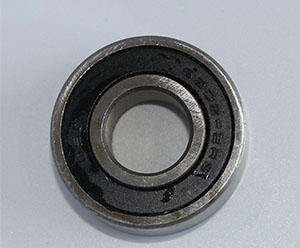
Diagram of bearing
Here’s a simple diagram illustrating the basic components of a bearing:
Explanation:
– Outer Ring (Race): The outer part of the bearing, usually stationary, provides support and facilitates the rotation of the bearing.
– Inner Ring (Race): The inner part of the bearing, typically attached to a rotating shaft.
– Ball Bearings: Small metal balls placed between the inner and outer races to reduce friction and facilitate smooth rotation.
This diagram represents a basic ball bearing configuration, which is one of the most common types of bearings used in various applications.
– Cage (optional): In some bearings, a cage or retainer may be used to keep the ball bearings evenly spaced and prevent them from rubbing against each other. This helps to maintain proper alignment and reduces wear on the bearings.
– Ball Bearings: These are the key elements that enable smooth rotation within the bearing. They are usually made of hardened steel or ceramic and are placed in a circular groove between the inner and outer races. The shape and arrangement of the ball bearings help distribute the load evenly and minimize friction during rotation.
– Seals or Shields (optional): In certain applications, bearings may be equipped with seals or shields to protect the internal components from contaminants such as dust, dirt, and moisture. Seals provide a barrier around the bearing, while shields cover the openings but allow some airflow. These protective features help maintain the integrity of the bearing and prolong its service life.
– Lubrication: Bearings require lubrication to reduce friction and wear. Lubricants such as grease or oil are applied to the contact surfaces between the ball bearings and the races to ensure smooth operation and extend the lifespan of the bearing.
– Load Capacity: Bearings are designed to support various types of loads, including radial loads (perpendicular to the shaft) and axial loads (parallel to the shaft). The load capacity of a bearing depends on factors such as its size, material, and design. Manufacturers provide load ratings to indicate the maximum loads that a bearing can withstand under specific operating conditions.
– Mounting: Proper installation and mounting of bearings are essential for optimal performance and longevity. Bearings should be carefully aligned and securely attached to their respective shafts or housings using appropriate mounting techniques. Improper installation can lead to premature wear, misalignment, and reduced efficiency.
– Application: Bearings are utilized in a wide range of industries and applications, including automotive, aerospace, industrial machinery, and household appliances. They are used in rotating components such as motors, pumps, gearboxes, wheels, and many others. The selection of the appropriate type and size of bearing depends on factors such as load requirements, operating conditions, and environmental factors.
– Specialized Bearings: In addition to standard bearings, there are specialized bearings tailored for specific purposes. These include high-temperature bearings, corrosion-resistant bearings, high-speed bearings, and precision bearings used in applications demanding exceptional performance under challenging conditions.
– Maintenance: Regular inspection and maintenance are necessary to ensure that bearings continue to operate smoothly and reliably. This may include lubrication replenishment, monitoring for signs of wear or damage, and periodic replacement of worn components. Proper maintenance practices can help extend the service life of bearings and prevent unexpected failures.
– Advancements in Bearing Technology: Over the years, advancements in materials, manufacturing techniques, and lubrication methods have led to improved bearing performance, reliability, and longevity. Innovations such as ceramic bearings, hybrid bearings (combining steel and ceramic components), and advanced coatings have expanded the capabilities of bearings in various industries.
– Types of Bearings: Bearings come in various types to suit different applications and operating conditions. Some common types include:
– Ball Bearings: Consist of steel balls placed between inner and outer races.
– Roller Bearings: Use cylindrical, tapered, or spherical rollers instead of balls.
– Thrust Bearings: Designed to support axial loads.
– Plain Bearings: Utilize surfaces sliding against each other with lubrication.
– Needle Bearings: Feature cylindrical rollers with a high length-to-diameter ratio.
– Spherical Bearings: Allow angular misalignment between the shaft and housing.
– Industry Standards and Regulations: Bearings are subject to industry standards and regulations governing their design, manufacturing, and performance. Compliance with these standards ensures that bearings meet quality and safety requirements and perform reliably in their intended applications.
– Future Trends: The future of bearings is likely to involve further enhancements in durability, efficiency, and sustainability. This may include the development of self-lubricating bearings, smart bearings equipped with sensors for condition monitoring, and eco-friendly bearing materials and manufacturing processes to reduce environmental impact.
NSAR group company and have our own factories overseas
NSAR bearings management team of managers, engineers, and technical staff have 15 – 25 years experience. We supply customers with bearings not only produced in our own factory, but also produced in professional bearings plants designated by NSAR brand to meet customers’ different requirements, such as pillow block bearings,we have designated a factory in northern China, which has perfect testing equipment and can develop products to customer needs very rapidly. Miniature bearings are arranged in the factory in southern China, which has enjoyed a good reputation long term in producing miniature bearings.
As a professional factory that produces professional products, with professional people doing professional things, our foreign customers have declared: “NSAR bearings have reached a domestic first-class and international brand-name quality, and NSAR bearing prices are 30-50% lower than international similar bearings.”
NSAR, as best 6300 bearings supplier, wholesale deep groove ball bearings, inlcuding wholesale 6308 bearings, wholesale 6307 bearing, 6306 bearings, wholesale 6305 bearing, 6304 bearings, 6302 bearings, 6309 bearings, 6311 bearings and deep groove ball bearings for household appliance and micro-motors supplies wholesale needs,products download.
Overall, bearings play a vital role in countless mechanical systems, enabling smooth and efficient motion while withstanding various loads and operating conditions. As technology continues to evolve, bearings will continue to evolve alongside, contributing to advancements in diverse fields and applications.

